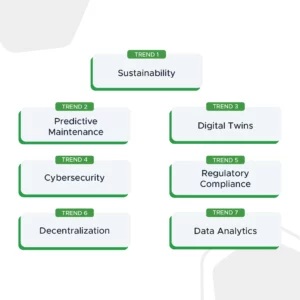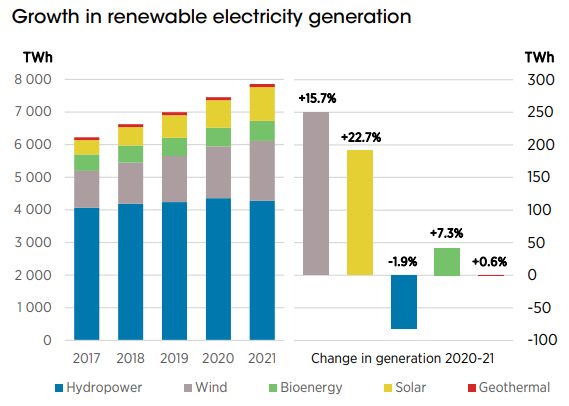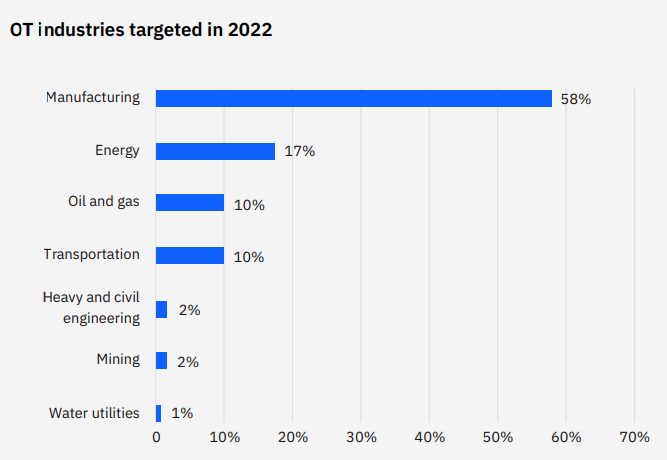
The utility industry, a cornerstone of modern infrastructure, is undergoing a significant transformation. Recent trends, primarily the shift toward renewable energy, are reflected in the changing statistics of the sector.
Strategic asset management in the utility sector is essential for maintaining the balance between operational efficiency and meeting customer needs. Let’s dig into the most important trends, challenges, and opportunities shaping asset management in the utility sector.
1. Increased focus on sustainability and green energy
The utility industry is increasingly embracing renewable energy — a strategic move to align with global sustainability objectives. Solar, wind, and hydro energies are at the forefront, reflecting the government’s and the sector’s proactive stance on contributing to a cleaner future.

Renewable sources of electricity. Source: IRENA
Integrating sustainability into asset lifecycle management has become a key focus for all utility companies. This approach goes beyond mere compliance, embedding environmental consciousness into all phases of asset management. From procurement to decommissioning, sustainability is now a defining factor in how assets are managed and maintained.
2. Implementation of predictive maintenance technologies
The implementation of Internet of Things (IoT) technologies alongside predictive analytics is revolutionizing maintenance strategies across various utility sectors. Using this approach is critical for shifting from preventive to predictive maintenance in order to enhance efficiency and reliability.
Here are some examples of predictive maintenance in different utility subsectors.
Electric utilities:
- Utilizing AI algorithms to analyze grid performance, predict potential outages, and schedule maintenance of transmission lines and substations.
- Implementing predictive models for forecasting, balancing, and integrating renewable energy sources, such as solar and wind, into the grid.
Waste management utilities:
- Employing sensor data to predict the lifespan of heavy-duty waste collection and processing equipment, ensuring timely maintenance.
- Advanced sensors for monitoring emissions from waste-to-energy facilities, predicting maintenance needs to comply with environmental standards.
Water utilities:
- Using real-time sensor data for predictive maintenance of water distribution and sewage pipelines to prevent leaks and breaks.
- AI-driven diagnostics for water and wastewater treatment plants to predict and prevent equipment failures.
Gas utilities:
- Implementing IoT-based solutions for continuous monitoring of gas pipelines, predicting potential leaks and ensuring safety.
- AI models to forecast and address regulatory compliance needs, particularly in emissions and operational standards.
Renewable energy utilities:
- Predictive maintenance of wind turbines and solar panels, considering environmental factors and operational conditions.
- Using predictive analytics for capacity planning and energy production forecasting in variable renewable energy sources.
In each of these sectors, predictive maintenance leverages IoT and AI to enhance asset reliability and ensure uninterrupted service delivery. To find out more about PdM in practice, have a look at our in-depth examples article.
3. Using digital twin technology for asset optimization
Digital twin technology involves creating a virtual representation of physical assets, enabling detailed analysis and monitoring. It helps companies proactively identify issues, optimize performance, and make data-driven decisions.
In the utility sector, digital twins are used for advanced monitoring and management of critical assets. This application is particularly beneficial for complex and interconnected utility systems.
For instance, utilities use a digital twin of the power distribution grid to simulate and analyze grid behavior. This helps predict the impact of different load scenarios and identify potential vulnerabilities. In the end, utility companies can then build more resilient systems, and prevent outages before they occur.
4. Continued battle with regulatory requirements
Compliance shapes strategies, often dictating the adoption of new technologies and processes. Utility companies must adapt their asset management practices to not only meet these regulations but also to maintain operational efficiency and reliability.
Striking a balance between regulatory demands and operational efficiency remains a key challenge for utilities. They must work to find innovative ways to align compliance with operational goals while still working toward efficiency and reliability. Many implement strategies like:
- Using advanced data analytics
- Integrating smart grid technologies
- Automating compliance and operational processes
- Adopting sustainable practices
- Investing in close collaboration with regulators
This balancing act is critical to ensure that regulatory adherence does not impede the utility’s performance or service delivery.
5. Enhanced cybersecurity measures for asset protection
As utilities become more interconnected and reliant on digital technologies, the risk of cyber threats grows. IBM’s Security X-Force Threat Intelligence Index report shows how energy firms were one of the most targeted in 2022, receiving around 20% of cyber attacks in the industrial sector.

The proportion of incident reports by OT-related industry to which X-Force responded in 2022
To counter these threats, utility companies are investing in secure software solutions, comprehensive training for personnel, and stringent cybersecurity protocols (regular system updates, rigorous access controls, and continuous monitoring for potential threats). Employee training and awareness are as crucial as technological defenses in the ongoing battle against cyber risks.
6. The shift toward decentralized energy systems
Marked by the rise of microgrids and Distributed Energy Resources (DERs), decentralization is reshaping the utility landscape. Moving away from traditional, centralized energy models, offers greater flexibility and resilience. More and more utility companies are recognizing the potential of this strategy to help them meet energy demands.
However, decentralized systems introduce new complexities to utility asset management.
Maintenance managers will have to reassess and adapt methods to monitor, control, and maintain diverse and geographically dispersed assets. Successfully managing these systems will demand innovative solutions and a willingness to embrace new technologies.
7. Data-driven asset lifecycle management
Data analytics has become a critical tool in modern asset lifecycle management, offering deep insights into asset performance and operational (in)efficiencies.
In the utility sector, complex algorithms analyze vast amounts of data to uncover trends and predict various issues. This empowers utility managers to make decisions that enhance asset longevity, reduce costs, and improve service delivery.
One example is Central Georgia EMC, which used SEDC’s ReportIQ Advanced analytics to harness data-driven insights. This initiative led to significant improvements across various functions, from customer service to operations.
CGEMC’s implementation of an Advanced Metering Infrastructure system, providing over 5 billion data points annually, was crucial in their transformation. The data analytics tool led to tangible benefits, including a reduction in line losses to below 3.5%, translating to an estimated annual savings of over $750,000 for each 1% of line-loss reduction.
Another example is Cognizant, who partnered with a utility company — serving around 1.1 million electric and 790,000 natural gas users — to upgrade its legacy systems and improve customer engagement. The focus was on using analytics to gain deeper customer insights and drive optimal business decisions.
The utility’s analytics implementation involved predicting and managing a high call volume and informing customers about outages via text or email. An intelligence platform was created for the existing IT landscape, alongside a business track for use case inventory and prioritization. This transformation expected a 7% reduction in the time customer care agents spent on the phone and a 13.6% decline in customer calls to call centers, ultimately saving an estimated $1 million annually due to fewer service calls.
Final thoughts
As the landscape of utility asset management continues to evolve, the sector faces both challenges and opportunities. Utility companies must remain agile and innovative, adapting to new regulations and embracing new technologies to enhance efficiency, resilience, and environmental stewardship.